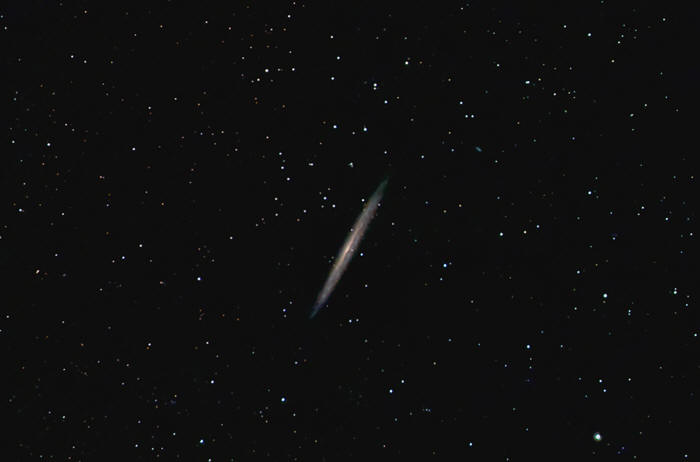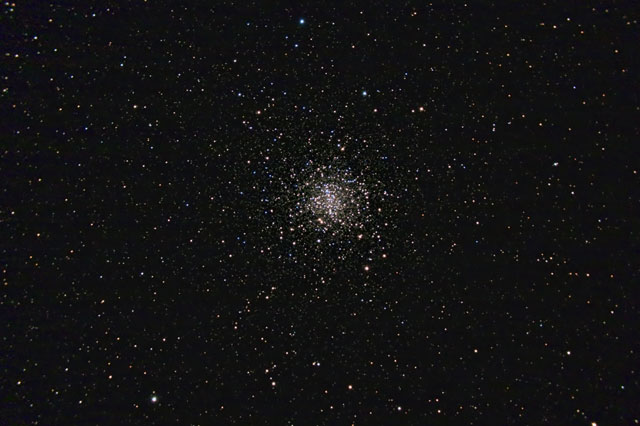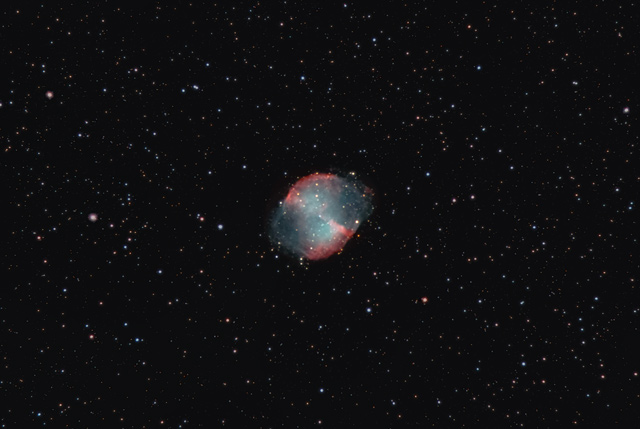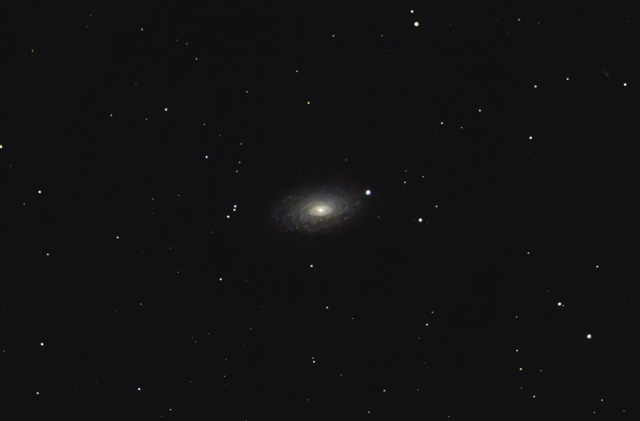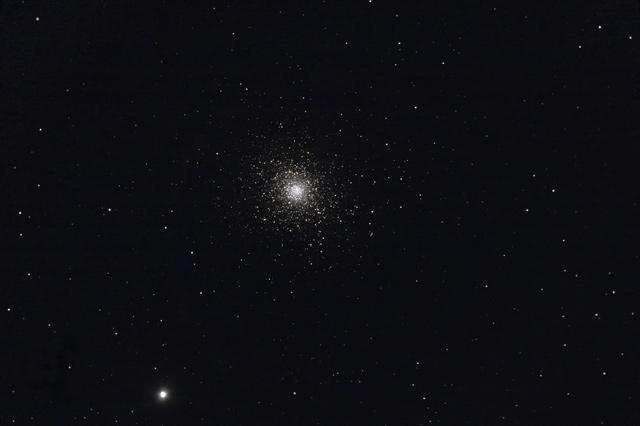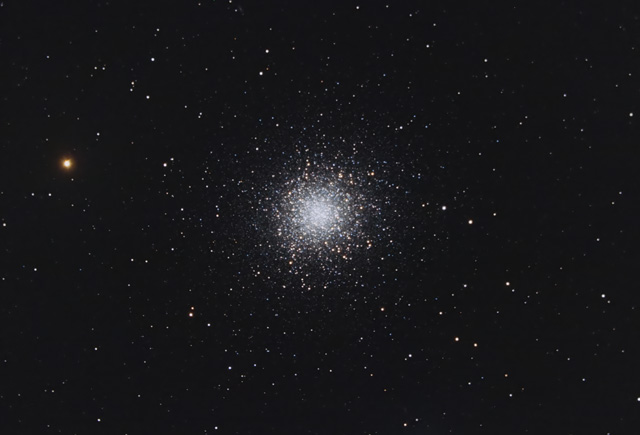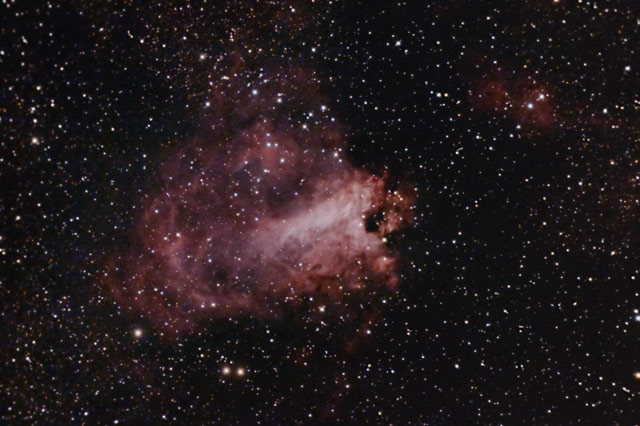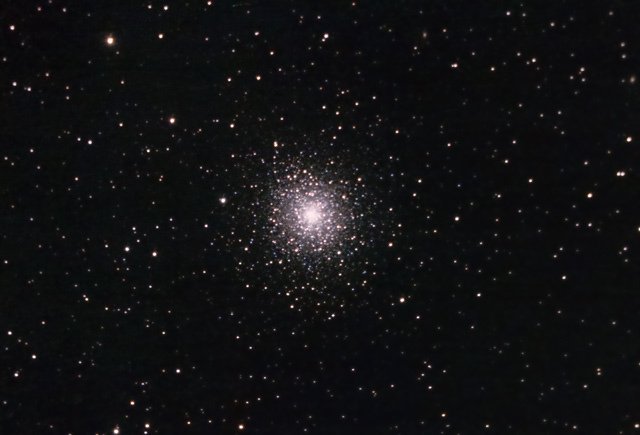______________________
NGC-5907 - The "Splinter Galaxy"
on 6/3/06
|
On Saturday, June 3, 2006 I had clear skies and time to do a little imaging. At first I went for Omega Centauri again, trying to get some more data to add to my existing image of it. I also did the same for NGC-5128. I am still working on those images. I also observed and imaged something new for the first time - NGC-5907, the "Splinter Galaxy" in Draco. This galaxy is one of the larger edge-on ones and I just love edge-on galaxies! |
|
NGC-5907, the Splinter Galaxy on 6/3/06. Taken with a Celestron C-8 at F/6.3 (1260mm.) Guided with a Meade DSI and 100mm F/5 refractor. Camera is a Hutech Type 1 modified Canon 350 XT. Exposure was 35x150 second sub-images at 1600 ISO. Processed and stacked in IRIS with dark, flat and bias calibration. Photoshop, RC-Astro's Gradient XTerminator and Noel Carboni's Astronomy Tools for post processing. Neat Image for noise reduction. Click here to see the full size hi-res version. |
______________________
Jupiter on 6/8/06
Still Image and Animated GIF
|
With the moon dominating the night sky in the first 2 weeks of June, 2006, I decided that a little planetary imaging was in order. I was waiting for a night with good seeing, and one came on the night of June 7/8, 2006. On this Wednesday night, I hooked up my Toucam Pro to the scope and captured some AVI movies of Jupiter. I managed to generate 6 good images with the data. Below is the first and last images from that session. Since I had more than one image, I made an animated GIF with them. It did not turn out too bad! Check out the stills and the animation below: |
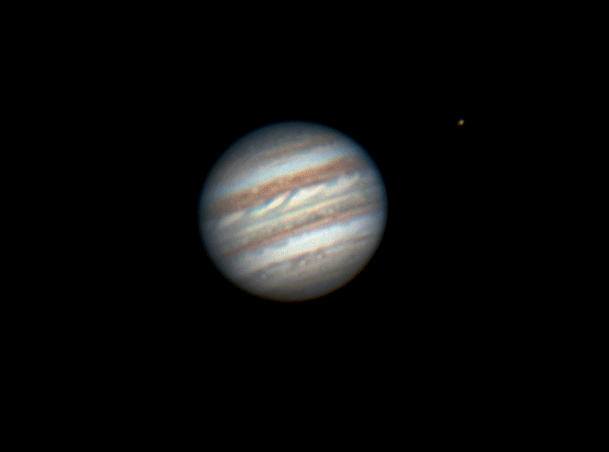
|
Jupiter on 6/8/06, 3:30 UT to 6:45 UT. Taken with a Celestron C-8 at F/10 (2000mm,) a Toucam Pro in RAW mode and a Celestron Ultima 2X Barlow. Guided with a Meade DSI and 100mm F/5 refractor. Acquired, processed and stacked in K3CCDTools 3. About 300 frames were used to create each image. Post processing for the still in Photoshop. |
______________________
M4 Globular Cluster in
Scorpius
on 6/4/06
|
Here is one I've been working on since May. I did several iterations of it until I finally got it somewhat the way I wanted. |
|
M4 Globular Cluster in Scorpius on 6/4/06. Taken with a Celestron C-8 at F/6.3 (1260mm.) Guided with a Meade DSI and 100mm F/5 refractor. Camera is a Hutech Type 1 modified Canon 350 XT. Exposure was 42x30 second sub-images at 1600 ISO. Processed and stacked in IRIS with dark, flat and bias calibration. Photoshop, RC-Astro's Gradient XTerminator and Noel Carboni's Astronomy Tools for post processing. Neat Image for noise reduction. |
______________________
The "Dumbbell" Nebula
on 6/10/06
|
On Saturday morning, June 10, 2006, I had a full moon to contend with, so I wanted a bright object to image. M27, the Dumbbell Nebula was almost overhead at the time, so it became my target. |
|
M27, the Dumbbell Nebula on 6/10/06. Taken with a Celestron C-8 at F/6.3 (1260mm.) Guided with a Meade DSI and 100mm F/5 refractor. Camera is a Hutech Type 1 modified Canon 350 XT. Exposure was 40x90 second sub-images at 800 ISO. Processed and stacked in IRIS with dark, flat and bias calibration. Photoshop, RC-Astro's Gradient XTerminator and Noel Carboni's Astronomy Tools for post processing. Neat Image for noise reduction. |
______________________
The "Sunflower" Galaxy
on 6/13/06
|
The first tropical storm of the season hit Florida's west coast on Tuesday, 6/13/06. Here in Louisiana on the backside of the circulation, we had northerly winds bringing clear and dry air down. Unfortunately, it was hot air. This is the first summer I use my modified Digital Rebel camera, and the heat makes digital camera images more noisy. But, it was very transparent on this night and I just had to give it a go anyway. Below is M63, the "Sunflower" galaxy in the heat. LoL! |
|
M63, the Sunflower Galaxy on 6/13/06. Taken with a Celestron C-8 at F/6.3 (1260mm.) Guided with a Meade DSI and 100mm F/5 refractor. Camera is a Hutech Type 1 modified Canon 350 XT. Exposure was 35x90 second sub-images at 800 ISO. Processed and stacked in IRIS with dark, flat and bias calibration. Photoshop, RC-Astro's Gradient XTerminator and Noel Carboni's Astronomy Tools for post processing. Neat Image for noise reduction. |
______________________
Globular Cluster M5
on 6/14/06
|
With summer here in force, nights are usually warm, and sky transparency low. Seeing is usually bad because of the heat. When we have a tropical storm pass to the east, conditions can improve briefly, but soon return back to the way they were. Such was the case on June 14, 2006. If you pick the right object to shoot, you can improve your odds of getting a decent image. A brighter globular cluster or open cluster will come out even if the sky is not very transparent. On this night, I picked M5, a globular cluster in Serpens Caput. I also processed it a certain way called "Drizzle" which improved the apparent resolution. Check it out: |
|
M5 Globular Cluster in Serpens Caput on 6/14/06. Taken with a Celestron C-8 at F/6.3 (1260mm.) Guided with a Meade DSI and 100mm F/5 refractor. Camera is a Hutech Type 1 modified Canon 350 XT. Exposure was 24x30 second sub-images at 800 ISO. Processed and stacked in IRIS with dark, flat and bias calibration. Photoshop, RC-Astro's Gradient XTerminator and Noel Carboni's Astronomy Tools for post processing. Neat Image for noise reduction. Click here for the full size image. |
______________________
Globular Cluster M13 Again
on 6/22/06
|
My favorite globular cluster, M13, was the target on this night to test the "drizzle" processing that I've been experimenting with for this type of object. |
|
M13 Globular Cluster in Hercules on 6/22/06. Taken with a Celestron C-8 at F/6.3 (1260mm.) Guided with a Meade DSI and 100mm F/5 refractor. Camera is a Hutech Type 1 modified Canon 350 XT. Exposure was 17x90 second sub-images at 800 ISO. Processed and stacked in IRIS with dark, flat and bias calibration. Photoshop, RC-Astro's Gradient XTerminator and Noel Carboni's Astronomy Tools for post processing. Neat Image for noise reduction. Click here for the full size image. |
______________________
The "Trifid" Nebula, M20
On 6/23/06 and 6/25/06
|
This object has got to be my favorite deep sky object of all time. The "Trifid" Nebula, M20, is a combination emission and reflection nebula visible near the heart of the summer Milkyway. This image was generated from 45 separate exposures. Five were taken on the 23rd and and additional 40 exposures were taken on June 25th, 2006. |
|
M20, The "Trifid" Nebula on 6/23/06. Taken with a Celestron C-8 at F/6.3 (1260mm.) Guided with a Meade DSI and 100mm F/5 refractor. Camera is a Hutech Type 1 modified Canon 350 XT. Exposure was 45x90 second sub-images at 800 ISO. Processed and stacked in IRIS with dark, flat and bias calibration. Photoshop, RC-Astro's Gradient XTerminator and Noel Carboni's Astronomy Tools for post processing. Neat Image for noise reduction. Click here for the full size image. |
______________________
The "Swan" Nebula, M17
On 6/24/06
|
A nice spell of good weather was still with me on 6/24/06. I took advantage of it to get images of my favorite summer deep sky object that I have previously imaged with smaller wide-field lens or scopes. The "Swan" Nebula image below is one of my best ever. I did not have an image of it taken at the prime focus of my C-8, but now I do! :-) |
|
M20, The "Trifid" Nebula on 6/23/06. Taken with a Celestron C-8 at F/6.3 (1260mm.) Guided with a Meade DSI and 100mm F/5 refractor. Camera is a Hutech Type 1 modified Canon 350 XT. Exposure was 4x90 second sub-images at 800 ISO. Processed and stacked in IRIS with dark, flat and bias calibration. Photoshop, RC-Astro's Gradient XTerminator and Noel Carboni's Astronomy Tools for post processing. Neat Image for noise reduction. Click here for the full size image. |
______________________
M92 Globular Cluster
On 6/25/06
|
My quest for globular clusters continues. There are hundreds of them to shoot, so I can usually find a good one to image. On this night, I picked M92, a globular cluster near the Great M13 globular cluster in Hercules. |
|
M92 Globular Cluster on 6/25/06. Taken with a Celestron C-8 at F/6.3 (1260mm.) Guided with a Meade DSI and 100mm F/5 refractor. Camera is a Hutech Type 1 modified Canon 350 XT. Exposure was 28x90 second sub-images at 800 ISO. Processed and stacked in IRIS with dark, flat and bias calibration. Photoshop, RC-Astro's Gradient XTerminator and Noel Carboni's Astronomy Tools for post processing. Neat Image for noise reduction. Click here for the full size image. |
All Images Copyright © 2006 Mike Broussard.
All rights reserved.
To send comments or for more information, please email me at
mike@synergyitg.com.
Visitors since June 7, 2006
